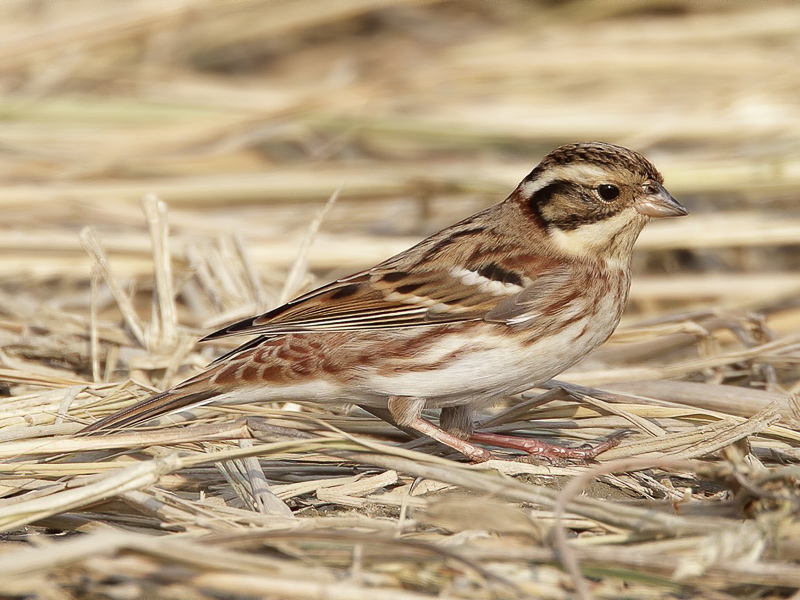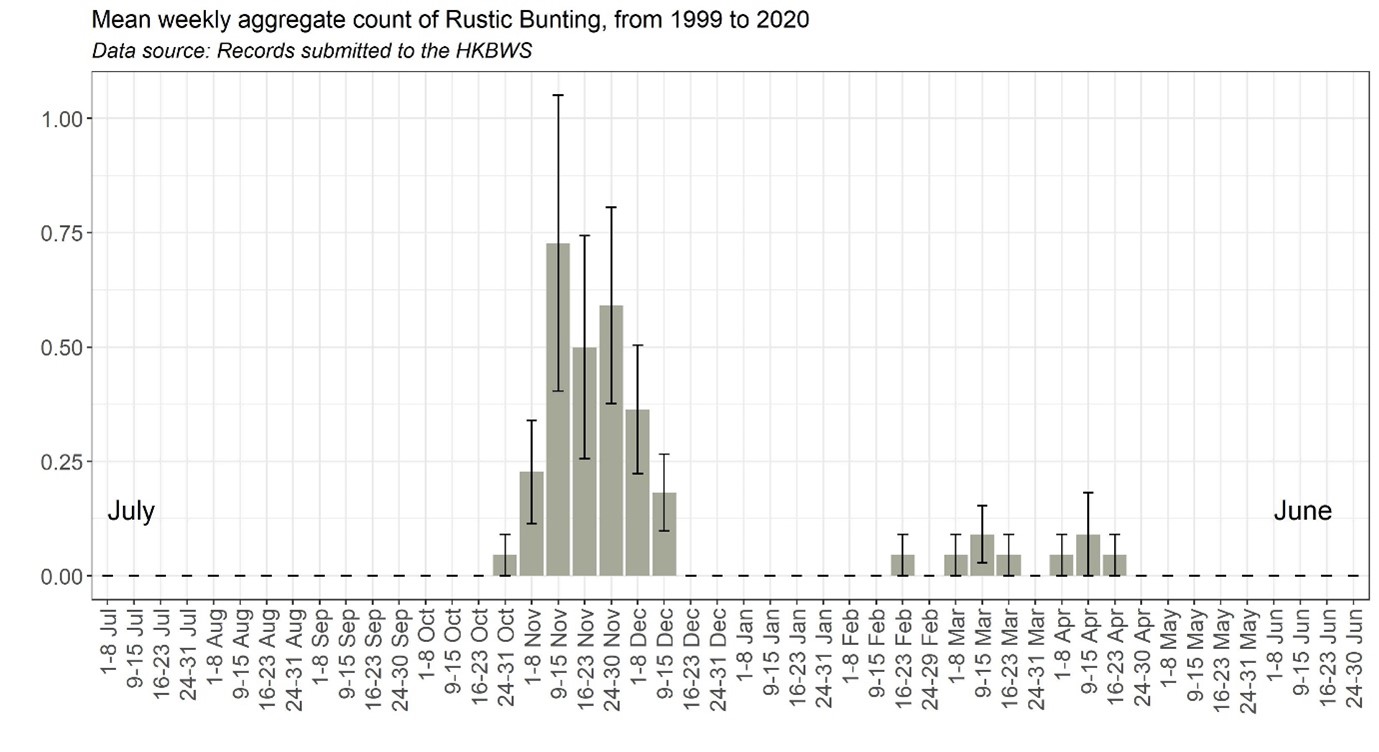Rustic Bunting Emberiza rustica 田鵐
Category I. Passage migrant, scarce in autumn, rare in spring. Occurs in open-country habitats, favours rice fields.
IDENTIFICATION

Nov. 2012, Martin Hale. First-winter male.
13-14.5 cm. Compact, slightly larger than Little Bunting, with which it shares a straight culmen. Flank streaks, rump and uppertail coverts rusty, lower mandible usually largely pale and legs pink. Pale buff supercilium and malar are prominent, while two pale wing bars are obvious.
Adult male has black and white head pattern but with white throat and rusty malar stripes that join rusty breast band. Small crescentic white patch at rear of ear coverts, rusty scapulars and rump, rather pale bill.

Oct. 2016, Ivan Tse. Female.
Female is duller than male with grey-brown replacing black except around rear of ear coverts. This very dull bird has a poorly marked head pattern and little obvious rusty colour on the upperparts and only dull rust streaks on the flanks.
VOCALISATIONS
The call is ‘tzit’, not as high in pitch as Little or Tristram’s Buntings.
DISTRIBUTION & HABITAT PREFERENCE
Approximately 70% of reports are from the agricultural fields of Long Valley, nearly all of which have occurred since 2012 due to the cultivation of rice, which is attractive to Rustic Buntings. This has dramatically changed our understanding of this species in HK. A further 12% are from Po Toi, which is attractive to many species of migrants. Other records are from Mai Po NR, the central New Territories and Lantau. Rare in fish pond areas.
OCCURRENCE
Carey et al. (2001) considered all spring records to relate to ex-captive birds in view of the fact that the species’ known non-breeding season distribution and timing of migration made it highly unlikely to occur in spring, which is when most records had occurred. As a result, the first accepted record occurred on 27 January 1997, and there were approximately 32 records up to the end of 2020, with all but seven of those occurring since 2010. This is almost certainly as a result of increased observer activity and the attraction provided by Long Valley to many bunting species, not just Rustic.
In autumn Rustic Bunting passes through rather late, which is not surprising given HK lies at the southern edge of the known non-breeding range (Copete et al. 2020). The earliest arrival date is 1 November, and most birds occur in the period from the second week of November to the first week of December. The latest autumn record occurred on 15 December 2014 and 2020. There are only two midwinter records: 27 January 1997 and 20 February 2020. Most records concern singles, but, based on plumage, four birds were present at Long Valley during 14-21 November 2014.
In regard to spring records, it is now accepted that Rustic Bunting occurs naturally at this time of year, though there is evidence suggesting that some birds that occur here may be ex-captive (some of the early records, for example, occurred in urban locations and were atypically tame). The earliest presumed northbound migrant appeared on 6 March 2005, while the latest in spring occurred on 20 April 2013; spring records are less than annual.
BEHAVIOUR, FORAGING & DIET
Raises crown feathers when alert or alarmed but can appear rather sleek when relaxed. Forages on seeds and rice.
RANGE & SYSTEMATICS
Monotypic. Breeds from Scandinavia east through the Siberian taiga as far as the Bering Sea, Kamchatka and north Sakhalin; winters in much of Japan, the Korean Peninsula and east China as far south as Fujian and Hunan (Copete et al. 2020, Liu and Chen 2020).
CONSERVATION STATUS
IUCN: VULNERABLE. Population decreasing rapidly, possibly due to habitat loss in breeding range, agricultural intensification in non-breeding range and large-scale trapping.
Figure 1.

Copete, J. L., E. F. J. Garcia, and C. J. Sharpe (2020). Rustic Bunting (Emberiza rustica), version 1.0. In Birds of the World (J. del Hoyo, A. Elliott, J. Sargatal, D. A. Christie, and E. de Juana, Editors). Cornell Lab of Ornithology, Ithaca, NY, USA. https://doi.org/10.2173/bow.rusbun.01
Liu, Y. and Y. H. Chen (eds) (2020). The CNG Field Guide to the Birds of China (in Chinese). Hunan Science and Technology Publication House, Changsha.

